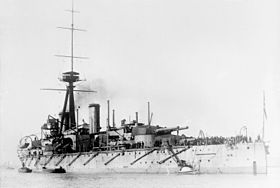Colossus class (1910)
|
|
|
|---|---|
| Colossus class | |
 The HMS Colossus |
|
| Overview | |
| Type | Battleship |
| units | 2 |
| Shipyard | |
| Order | 1908 |
| Keel laying | 1909 |
| Launch | 1910 |
| period of service |
1911-1922/1923 |
| Technical specifications | |
| displacement |
20,225 ts standard |
| length |
166 m |
| width |
26 m |
| Draft |
7.7 m |
| crew |
755 |
| drive | |
| speed |
21 kn |
| Range |
6680 nm at 10 kn, |
| Armament |
|
|
Armor side armor upper armored deck lower armored deck barbeds turrets command tower underwater protection armored transverse bulkheads armored bulkheads for ammunition chambers |
178 mm to 279 mm |
The Colossus class was a British class of battleships with a displacement of 23,000 tons. The Colossus class included the HMS Colossus and the HMS Hercules .
history
The two ships of the Colossus class were approved in 1909 as successors to HMS Neptune . The gun arrangement of the Neptune was retained, but the armor was slightly changed. Both ships belonged to the Home Fleet during World War I and were scrapped in accordance with the provisions of the Washington Fleet Agreement of February 6, 1922.
draft
Main armament
As with the Neptune, the 12 inch guns were set up in five twin towers. The two side towers were offset diagonally, the two rear towers were erected over the top. As a result, the sweep angle of the individual towers and thus the bullet weight of a broadside was considerably increased compared to the previous battleships.
Secondary armament
With these ships, the Royal Navy increased the caliber of torpedo armament in battleships from 45.7 cm to 53.3 cm.
The 4 inch anti-torpedo boat guns were set up individually in the superstructure without armor protection. In 1917 the ships had to surrender three guns to arm escort vehicles. In return, they received two anti-aircraft guns.
Armor
The armor was changed compared to the Neptune . The thickness of the side armor was increased, but the ends of the ship were no longer armored. For this, four instead of two armored transverse bulkheads were installed. In contrast to the Neptune, no torpedo bulkhead was used for underwater protection , only the ammunition chambers of the main artillery were protected by armored bulkheads.
Conclusion
The ships could not be seen as an improvement on the Neptune . In addition to the poor underwater protection, the arrangement of the front chimney in front of the mast led to constant smoke nuisance at the artillery control center. In the same year, parliament approved the Orion class with a more powerful main artillery.
Ships of the class
- The HMS Colossus was launched on April 9, 1910 at Scotts in Greenock. During the First World War it was part of the Grand Fleet . She received two medium hits during the Battle of the Skagerrak . From 1919 she served as a cadet training ship and was temporarily given the black and white paintwork of the Victorian era. In 1923 it was dismantled and used as a Hulk , in 1928 it was sold for demolition and scrapped.
- The HMS Hercules was launched on May 10, 1910 at the Palmers shipyard in Newcastle. In the First World War she belonged to the Grand Fleet and took part in the Battle of the Skagerrak. In 1918 an Allied armistice commission brought them to Kiel. From 1919 she was part of the reserve fleet. In 1922 it was sold for demolition and scrapped.
literature
- Siegfried Breyer: Battleships and battle cruisers 1905–1970. JF Lehmanns Verlag, Munich 1970, ISBN 3-88199-474-2 .